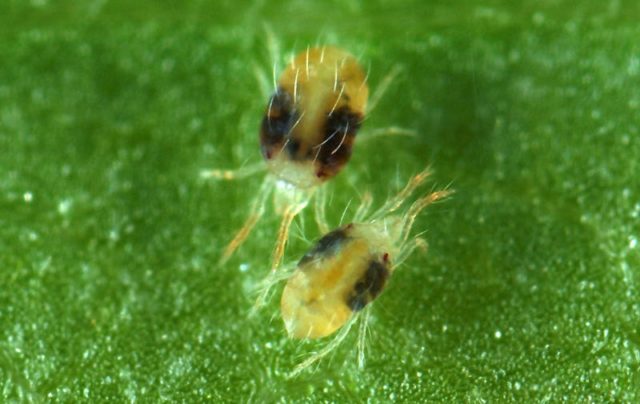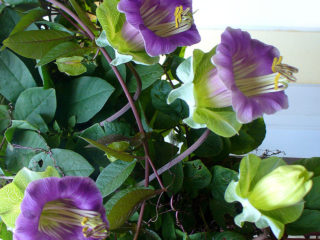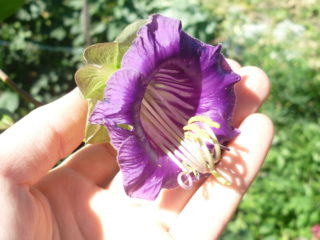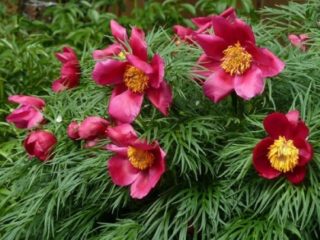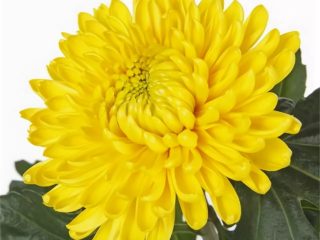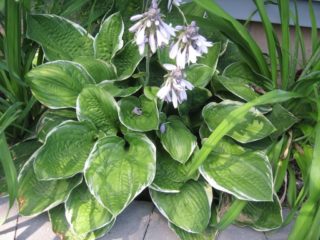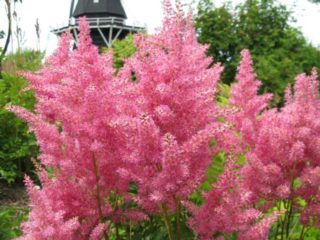Content
Kobeya climbing is a climbing semi-shrub vine widely used in vertical gardening of garden plots due to its ability to quickly grow and "conquer" almost any surface and height. Numerous shoots of this plant are densely covered with openwork feathery leaves that look very decorative. From July to October, large bright flowers in the form of intricate bells appear on the climbing kobee, exuding a pleasant aroma. At home, in the tropics of Mexico and Peru, it is a perennial plant. In the Russian climate, it is usually grown as an annual and is most often propagated by seed. However, if the climbing kobe is given the opportunity to overwinter in the basement in a container, then spring cuttings are also practiced. Rooting of bush cuttings buried in the ground is also possible. Climbing kobea, growing in open ground, needs proper care: organization of strong support, regular watering and spraying, application of top dressing. Observing these conditions, you can get a luxurious green growth in a short time, which can quickly turn even the most unsightly fence into a lovely hedge.
Description of climbing kobei
Kobeya climbing, tenacious, creeping (in Latin Cobaea scandens) is the only one of 9 species of semi-shrub vines, united in the genus Kobeya of the Sinyukhov family, which is grown in cultural gardening. In 1787 the Spaniard Barnabas Cobo, a Jesuit monk, impressed by the beauty of this plant, brought it from Mexico to his homeland, to Europe, to decorate his own garden with a charming Tropicana.
In the wild, this vine grows in a humid hot climate - it is extremely thermophilic. In the conditions of the tropics and subtropics, the kobea climbing exists as a perennial plant. However, in harsher climates, with at least a slight frost in winter, it is usually grown as an annual.

Kobeya climbing - brightly blooming tropical liana with dense greenery of branching shoots
Kobeya climbing has a powerful, branched root system, consisting of thin fibrous roots. Its numerous shoots spread out to a distance of 4-6 meters, clinging to all kinds of supports with antennae located at the ends of the leaves. The latter are very strong and resemble compressed springs.
The leaves of the climbing kobei are complex, feathery, with a slightly wrinkled surface. They are located alternately.
Long (up to 20 cm) peduncles of the climbing kobei are placed in the leaf axils. By July, from 1 to 3 ribbed buds of a greenish color are formed on each of them.When large (up to 8 cm in diameter) flowers bloom, resembling bells in shape, they gradually change their tone to the one that corresponds to the variety: usually dark or light purple or greenish-white. The climbing kobe has long stamens and a pistil, prominently protruding from the corolla of the petals. Recent buds usually smell like musk, and open flowers exude a honey scent.
Flowering usually lasts until October.
The fruit of the climbing kobei is a leathery capsule. Inside there are large, flat, round seeds. In the temperate zone, they usually do not ripen.
Application in landscape design
Kobeya climbing perfectly copes with the task of vertical gardening of garden plots. Landscape designers highly appreciate its ability to grow quickly and densely, as well as to braid any planes and structures. In particular, climbing kobe is great for achieving the following goals:
- the creation of "green walls" and hedges by planting lianas near the southern walls of houses, arbors, arbours, pergolas, near fences and barriers;
- braiding of arched structures, shapes and figures from a strong mesh or wire;
- revitalizing the garden with bright flower beds in combination with lobelia, verbena, petunia and other flowering annuals;
- in combination with other climbing plants: honeysuckle, honeysuckle, hops, climbing roses, clematis;
- hiding the architectural flaws of various buildings located on the site;
- colorful and long-blooming "green curtains" in greenhouses and conservatories;
- decoration of a loggia, veranda or terrace when growing in a portable container or flowerpot.
A good example of a composition using a kobei climbing in a garden is shown in the photo:
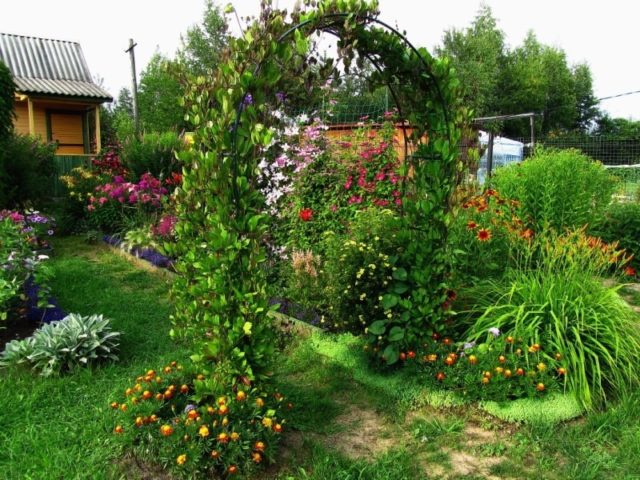
Climbing kobea will quickly braid and fill any metal structure
The climbing kobea is quite capable of using the branches and trunks of its closest neighbors as a support, often drowning and shading them. It is important to maintain a suitable distance between the plants and remove overgrowing vine shoots.
Breeding features
Breeding methods for climbing cobei:
- Growing from seeds. In temperate climates, exclusively the seedling method is practiced. At the beginning of the growing season, the climbing kobe is extremely sensitive to a drop in temperature, fluctuations in air and soil humidity. Sowing seeds directly into open ground is not possible under such conditions.
- Rooting green cuttings... They are cut from plants that have wintered in containers indoors, and with the onset of spring planted under the open sky in the garden. For cuttings, young strong shoots of kobei climbing 15-25 cm long, having 2-4 pairs of leaves, are used. Wet sand is used for rooting, the place should be shaded. It is noteworthy that the climbing kobe, propagated by cuttings, grows faster than plants obtained from seeds, but its flowering is not so long and abundant.
- Digging in layers... For this, a healthy, powerful shoot, located close to the ground, is chosen from an adult plant. A long groove is dug into the ground, a layer of climbing cobei is laid there and sprinkled with soil. The tip of the shoot is slightly pinched and left on the surface. In order for the climbing kobei to hold tightly, it is fixed with a "hairpin" made of wire. The soil at the planting site should be kept moist. After a while, the cuttings of the climbing kobei will sprout with young shoots.
Growing seedlings
Basically, this vine is propagated by seeds. First, they are germinated indoors, creating the most favorable conditions for the development of young plants. A few months later, with the onset of stable warm weather, the mature seedlings are moved to a permanent place in the open ground.

Kobei flowers acquire the characteristic color of the variety gradually.
When to plant a climbing kobei for seedlings
The dates for planting seeds of kobei climbing seedlings, as a rule, come at the end of February or at the beginning of March. They should be planned taking into account the 2-3 days required for pre-sowing preparation, and a couple of weeks that will be required for germination.
Preparation of containers and soil
For young seedlings of climbing kobei, the following planting containers are suitable:
- Wide boxes or containers about 15 cm deep with numerous drainage holes in the bottom.
- Individual pots, cups or peat tablets.
- The so-called "sleeves". They are easy to make by wrapping a glass with foil in 2-3 layers, but without capturing the bottom. Several rows of such cylinders should be installed in a wide pan with holes to drain excess water, and then filled with soil.
The potting mix should be loose, light and nutritious. The following composition is quite suitable for climbing kobei seedlings:
- sheet land (4 parts);
- garden soil (2 parts);
- humus (2 parts);
- coarse sand (1 part).
Presowing seed preparation
Since the seeds of kobei climbing usually do not germinate well, they need mandatory pre-sowing preparation and preliminary germination. It is also important to plant on time, otherwise you can not wait for flowering.
First of all, the seed material of the climbing kobei should be soaked for some time in a solution of a growth stimulator. Its composition may be as follows:
- 4 drops of Epin Extra or 5 drops of Zircon per 100 ml of water (keep the seeds for 4 hours);
- 1 part aloe juice and 1 part honey (immerse the seed for 1 hour).
After processing, the seeds of the climbing kobei must be dried in the air, and then carefully laid out on gauze, a cloth napkin, a piece of toilet paper folded in several layers so that they do not touch. The fabric needs to be moistened, covered with cling film and placed in a warm (about + 22-25 ° C) shaded place. The condition of the seeds of the climbing kobei should be monitored every day. If plaque or mold is visible on them, the film should be lifted and gently wiped with a cloth moistened with a weak solution of potassium permanganate. After about 2 weeks, some of the seed will germinate.

Seeds have low germination and need preliminary soaking and germination
How to sow the seeds of a climbing kobei
The algorithm for planting seeds of climbing kobei is simple:
- The prepared containers are filled with a suitable substrate.
- Sprouted seeds are carefully laid out on the surface with the convex side up. If containers for group planting are selected, then the distance between individual specimens of the climbing kobei is left large - about 20 cm.
- The seeds are covered from above with a layer of sifted substrate 1.5 cm thick.
- Moisten the soil from a spray bottle.
- Transfer the container to a warm, bright place.
Seedling care
The subtleties of caring for seedlings of climbing kobei at the initial stage are reduced to the following points:
- maintaining a constant air temperature not lower than + 17-20 ° С;
- a sufficient amount of diffused lighting, protection from direct sunlight;
- regular moderate soil moistening.
After the appearance of the first true leaf, the seedlings of the climbing kobei should be dived together with a lump of earth into separate pots with a capacity of about 3 liters.
Caring for them will need to be supplemented with the following measures:
- organization of support for each sprout: a peg about 0.5 m high;
- maintaining high humidity through spraying;
- pinching the tops of the seedlings of the kobei climbing one month after the pick;
- hardening of seedlings - gradually accustoming it to open air in good weather (3-4 weeks before the intended landing in a permanent place).
Planting and caring for a climbing kobe in the open field
In late spring or early summer, it is time to "relocate" the seedlings of the kobei climbing into the garden. Outdoor care for this flower has its own specifics.
Recommended timing
The main criterion for determining the time for planting a kobei climbing to a permanent place in the garden is the onset of stable warm weather without the threat of recurrent frosts. Depending on the characteristics of the climate, the optimal conditions for this procedure usually develop from the end of May to the middle of June.
Site selection and soil preparation
The place where the climbing kobee is to grow should be well lit and protected from strong winds, with loose, crumbly, moisture-consuming and fertile soil.
It is recommended to dig up the soil in the garden, adding for each square. m area:
- 1 bucket of peat;
- 0.5 buckets of sand;
- 1 bucket of vegetable humus.
In addition, in order to ensure the active growth of the climbing kobe, it is desirable to enrich the soil with nitrogen-containing fertilizers (urea, urea). You will need to add 30-40 g of granules per square meter. m plot.

Kobei seeds should be germinated in deep containers filled with loose, fertile soil.
Landing algorithm
Planting kobei climbing to a permanent place in the garden is performed as follows:
- Holes are dug in the ground at a distance of 60-80 cm from each other. Their depth should be such that the roots of the seedlings do not bend during the transplanting process.
- Seedlings of climbing kobei are watered abundantly.
- The bushes are taken in turn from the pots along with a lump of earth on the roots. If the containers are plastic, they are usually simply cut along the walls and removed, gently releasing the plants.
- Each seedling is placed vertically in the hole and the soil from the garden is covered under the roots.
- Water the plantings from a watering can with a fine sieve.
Support installation
Immediately after planting a climbing kobei, you will need to provide it with reliable support. Otherwise, the shoots of the plant will seek random support, using the surface of the soil, as well as shrubs and flowers growing in the immediate vicinity.
The overgrown climbing kobe is quite heavy, so the support must support its weight. This can be a rope, a strong net made of various materials, a wire frame, a trellis, etc. At first, the stems of young seedlings of climbing kobei must be tied to a support. Then they will begin to curl around it on their own.
Watering and feeding schedule
Kobeya climbing needs moderate watering throughout the season. On hot dry days, the frequency of procedures and the amount of added moisture increase, however, it is important to ensure that the soil does not become waterlogged. It is advisable to pour water between the bushes of kobei climbing, and not aiming at the very roots.
Top dressing is recommended to be applied 2 times a month, starting from the second week after the vine is transplanted into the ground. At first, it is better to use nitrogen-containing fertilizers - they will contribute to the active growth of the green mass of the climbing kobe. At the stage of the appearance of buds and flowers, it is desirable to give preference to compositions with a predominant content of phosphorus and potassium.
Flowering care
The tactics of caring for a flowering kobeya involves the continuation of all those measures that were taken after planting the plant in the ground. At this stage, it is desirable:
- devote time to regularly examining the overgrown lashes of the kobei climbing for diseases and pests;
- set the desired direction for the growth of shoots, tying them up if necessary;
- from time to time remove the yellowed leaves and wilted "bells" of the climbing kobe to preserve the decorative appearance of the plant.
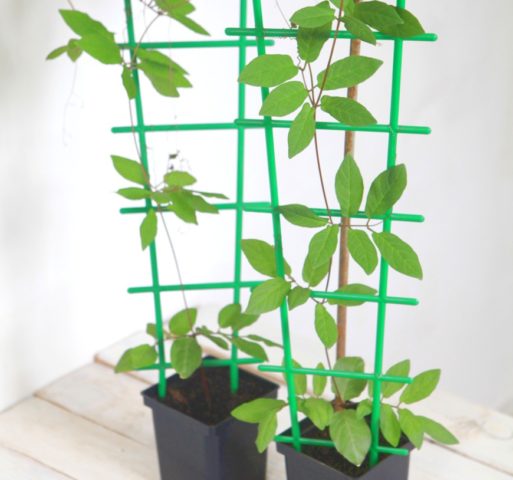
Starting from the picking stage, the seedlings will need support
Preparation for wintering
Since the climbing cobe belongs to tropical plants, in the temperate climate zone it is not able to endure winter in the open field.
If the gardener wants to save the vine for the next year, he must:
- before the onset of frost, cut off the entire aerial part of the climbing kobei at a level of 0.2-0.5 m from the ground surface;
- carefully dig out the rhizome of the plant with a lump of earth;
- transplant it into a container filled with fertile soil;
- transfer to a cool dark room (basement), where and store it throughout the winter at a temperature of about + 5-8 ° C;
- regularly inspect the rhizome of the climbing cobea and slightly moisten the soil, preventing it from drying out too much.
In the spring (in March), shortly before returning to the garden, the container with the vine should be brought into a warm room, increased watering and wait for the shoots to grow.

Kobei rhizome can be dug up before the onset of frost and stored until spring
Diseases and pests
Climbing kobea often suffers from such diseases and pests:
- Root rot... It usually develops as a result of stagnation of moisture in the soil caused by excessive watering or poor drainage in the area where the climbing cobea grows. External signs of the disease are numerous black spots on the leaves and flowers. The damaged organs of the kobei must be cut off, carefully loosened the soil at the roots and let it dry well, and then spill with a solution of a fungicidal preparation. Prevention measures will help to avoid the disease: regulation of irrigation water volumes and prevention of waterlogging of the soil.
Root rot is easier to prevent by preventing waterlogging of the soil
- Spider mite... Prolonged intense heat creates favorable conditions for the rapid reproduction of this pest. The presence of microscopic cobwebs on the stems and the back of the leaves of the kobei will help to identify it. The green mass begins to turn yellow, dry and crumble. To combat spider mites, spraying kobei with climbing compounds prepared according to folk recipes (infusion of pine needles or mustard powder) or chemical preparations (Aktellik, Fitoverm, Decis) is used.
Very hot weather often contributes to spider mite attacks
- Aphid... As a rule, this parasite attacks already weakened plants. Garden ants help aphid colonies move long distances, so you should fight with them too. The pest feeds on the juices of plant leaves, as a result of which the plates rapidly turn yellow and curl. If the infection is insignificant, you can try to treat the green mass of the kobei with a climbing solution of green or laundry soap, tincture of garlic or onion peel.
With a significant degree of damage, it is necessary to use chemicals (Actellik, Fufanon, Fitoverm)
Is it possible to collect seeds of climbing kobei
Climbing kobei seeds do not have time to ripen in temperate climates. The seed for the new season will have to be purchased again at the store. It is advisable to choose trusted suppliers.
Conclusion
Kobeya climbing is a charming tropical plant that can decorate a garden in a temperate climatic zone. Beautiful long shoots with emerald green curly leaves and bright wine-white or purple flowers invariably attract attention. The ability of the kobei to grow intensively and, clinging to its antennae, to climb on almost any surface makes it an ideal "assistant" for a landscape designer who wants to decorate a gazebo or an arch, zoning a site using "green walls" or masking building flaws. Usually this beauty is grown as an annual, however, if you are not too lazy to cut the plant before the onset of cold weather, dig up the rhizome and store it in the basement, you can return it to the garden next spring.Most often, the seedling method is used for reproduction of the climbing cobei, however, the seed should be purchased from year after year in stores, since outside the tropics and subtropics, the seeds do not have time to ripen in their natural environment.

